
"The scientist shouldn't become too adventurous, too competitive. The trouble is, we're all so human. I've never seen a case more governed by human frailties."
--Dr. Tony Jones, government pathologist in the Chamberlain trial
On August 17, 1980, at a campsite near Australia's famous Ayer's Rock, a mother's cry came out of the dark: "My God, my God, the dingo's got my baby!" Soon the people of an entire continent would be choosing sides in a debate over whether the cry heard that night marked an astonishing and rare human fatality caused by Australia's wild dogs or was, rather, in the words of the man who would eventually prosecute her for murder, "a calculated, fanciful lie." A jury of nine men and three women came to believe the latter story and convicted Lindy Chamberlain for the murder of her ten-week-old daughter, Azaria.
Three years later, while Lindy dealt with daily life in a Darwin prison, police investigating the death of a fallen climber discovered Azaria's matinee jacket near a dingo den, and the Australian public confronted the reality that its justice system had failed. "A Cry in the Dark," a movie starring Meryl Streep, carried the story of Lindy's wrongful conviction across oceans. What went wrong? Convictions of the innocent usually result from inaccurate eyewitness testimony (generally the least reliable evidence in a trial because of biases and the tricks of memory), but Lindy Chamberlain was convicted by flawed forensic evidence and by investigators and prosecutors unwilling to reconsider their assumptions in the face of contradictory evidence. The trial of Lindy Chamberlain, and her husband Michael, is a cautionary tale that everyone who practices forensic science should carefully consider.
Azaria Disappears
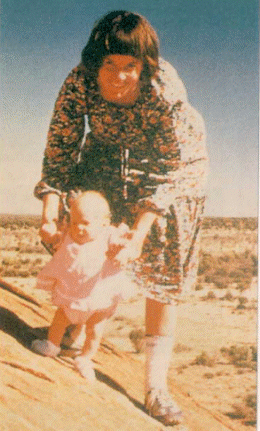
Lindy and Azaria Chamberlain at Ayers Rock
Improbably shaped Ayers Rock rises 348 meters out of the dry Aboriginal heart of Australia. The monolith, called Uluru by natives, lures tourists drawn by its imposing shape and colors that migrate from gold to red in the changing sunlight. On August 13, 1980, the Chamberlain family left their home in the northern Queensland mining town of Mount Isa, heading west and then south to see central Australia's most famous natural feature. At the time of their trip, Michael Chamberlain served as minister at Mount Isa's Seventh Day Adventist Church, a denomination much misunderstood Down Under. He and his wife of ten years, Lindy, looked forward to several days of tenting and exploring with their three children, Aidan (age 6), Reagan (age 4), and Azaria (ten weeks).
The Chamberlains arrived late on the night of August 16 at the Ayers Rock campground. The next morning, Michael and the two boys climbed portions of the rock. Lindy, cradling Azaria in her arms, explored a formation called Fertility Cave. Just outside the cave, she looked up uneasily to see a dingo staring at her. She would later tell a detective that she had the feeling that the wild dog was "casing the baby."
After sunset, the Chamberlain family gathered with other campers around the barbecues near their tent site. Lindy held her Azaria in her arms as she and Michael chatted with Greg and Sally Lowe, another young couple also vacationing with an infant. Around 8:00, as Sally Lowe walked to a rubbish bin to dispose of items left from the evening meal, she turned to see a dingo following four or five paces behind her. Minutes later, Michael entertained his son Aiden by tossing a crust of bread to a dingo that appeared near their barbecue bench. Lindy remonstrated, "You shouldn't encourage them" about the same time as the dingo pounced on a mouse that young Aiden had been chasing.
Lindy announced "It's time I put Bubby down" and retreated to the Chamberlain's tent to make a suitable bed for Azaria. Ten minutes later, having left Azaria with her sleeping brother, Reagan, in the tent, Lindy rejoined the rest of the campers by the barbecue bench. A baby's cry from the direction of the tent soon sent Lindy racing back to investigate. Then came her cry: "My God, My God, the dingo's got my baby!"
Frank Morris, the first investigator to arrive, shined a light across the floor of the Chamberlain tent, where he noticed blood on one of the rugs. Paw prints led away from the tent entrance, but faded as they hit a road. Meanwhile, six-year-old Aiden wailed to Sally Lowe, as he showed her the empty bassinet, "The dingo has our Bubby in its tummy."
Soon campers were locating flashlights ("torches," in Australian) and heading out into the dark scrub land. Nearly 300 men, women, and teenagers formed a human chain to look for tracks or pieces of clothing. Michael, who did not join the chain, had already assumed the worst, telling a fellow camper, "She's probably dead now." Then he added, incongruously, "I am a minister of the gospel."
The main search turned up dingo tracks, but nothing more. Away from the chain, tourist Murray Haby had better luck, following the tracks of a large dingo under a sand ridge, Haby noticed a depression in the sand where the wild dog seemed to have laid down something it had carried. Called by Haby to investigate, ranger Derek Hoff and native tracker Nuwe Minyintiri studied the depression. The imprint in the sand suggested a knitted weave of some sort. The men looked for dingo tracks leading on from the depression, but the task proved hopeless.
First Doubts
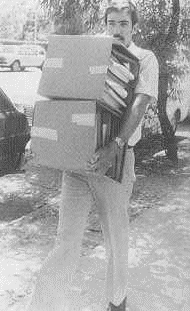
Detective Sgt. Graeme Charwood (Barry O'Brien photo)
The four law men first assigned to the Chamberlain case talked over drinks at the Red Sands Motel. Inspector Michael Gilroy accepted the Chamberlain's story, while Frank Morris kept his own counsel. John Lincoln, according to John Bryson's account in Evil Angels, doesn't buy the dingo story: "Not a chance. Never happened before. There's a fact you can't beat. Never ever happened." Gilroy noted that, even though none before had been fatal, there had been a series of recent dingo attacks in the park on children. Lincoln scoffs at the possibility that a dog could lug a ten pound baby over hundreds of yards. To prove his point, he leaves the room and returns with a pail filled with ten pounds of sand, which he succeeds in supporting by his mouth for less than a minute. He challenges the other officers to see if they can do better.
One week after Azaria's disappearance, Wally Goodwin set out for a gully at the base of Ayers Rock, with plans to photograph wild flowers along the way. While walking along a densely foliated animal path, Goodwin spotted shredded clothes resting near a boulder. Upon closer inspection, the proved to be a torn nappy and a jumpsuit. Goodwin reported his discovery and Constable Morris arrived to collect the evidence.
On August 28, Detective-Sergeant Graeme Charlwood took over the Chamberlain investigation. While subordinates checked vehicle registrations of August 17 campground visitors, Charlwood could ponder Inspector Gilroy's initial report on the case, which included suspicious tidbits of information. Gilroy reported that when Lindy had brought Azaria in for a medical check up, the baby was dressed in all black. The examining doctor is said to have been curious enough about the name "Azaria" to look it up in a Dictionary of Names and discover that it meant "Sacrifice in the Wilderness." (Actually, it means "Whom God Aids.") Gilroy also commented that Azaria's clothes were found close to where the family hiked earlier in the day. He noted that the people who observed her that evening "assumed she was holding a baby when they have seen her holding a white bundle to her breast."
In places around Australia, ranging from laboratories to wildlife parks, investigators conducted experiments to test the veracity of Lindy's account of Azaria's disappearance. Blood, vegetation, and hair samples found on Azaria's clothing were examined. Dead dingoes shot in the Ayers Rock region following the disappearance were dissected by veterinarians looking for either human bone or human protein. Tears in the fibers of Azaria's clothing were studied--Did the tears appeared to be caused by a dingo's teeth or by some human instrument? At Cleland Park wildlife reserve in Adelaide, dingos were tossed meat wrapped in a baby's nappy, so that the nappy could be studied and compared to Azaria's. From these various efforts, investigators began to build a case for murder.
Newspapers fueled suspicions that the Chamberlains killed their baby, possibly as a religious sacrifice. Stories reported rumors that the Chamberlains were somehow linked to the Jonestown mass suicide two years earlier, or that Azaria might have been killed to atone for sins of the Seventh-day Adventist church. Reporters frequently observed that the many Australians concluded from televised interviews with the fatalistic Chamberlains that the couple's demeanor didn't match what they would expect from a couple that had just tragically lost a child.
On October 1, 1980 in Mount Isa, Charlwood conducted a several-hour-long separate interviews with Lindy and Michael Chamberlain. His questions took her along the timeline from their departure for Ayers Rock to the days following Azaria's disappearance. The interview was relatively cordial, but Lindy expressed repeated frustration with leaks to the press of forensic tests that seemed to cast doubt on her account of events. Charlwood took particular interest in Lindy's unusual reaction to his suggestion that she be hypnotized in an effort to pull out additional details concerning her sighting of the dingo around the tent. Lindy immediately rejected the idea saying, "The church wouldn't allow it and I wouldn't do it. God slew Saul for that. Do you know Saul and the Witch of Endor?"
First One Coroner's Inquest, Then Another
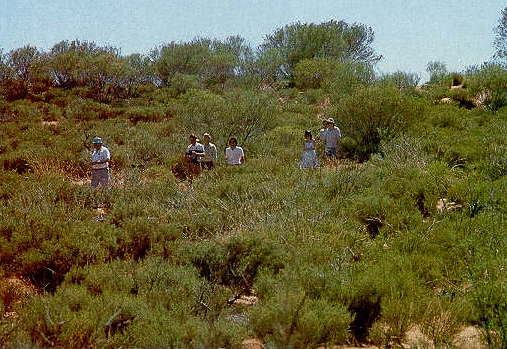
Retracing route of dingo's tracks during the first inquest
It fell to the magistrate and coroner of Alice Springs, Denis Barritt, to conduct what would eventually turn out to be the first of three coroner's inquests into the death of Azaria Chamberlain. Journalists crowded into Barritt's no. 2 courtroom, with its high ceilings, polished furniture, and landscape paintings. The inquiry opened on December 16, 1980 with Ashley Macknay for the Northern Territory laying out the case for human intervention in her death. The evidence suggests that the clothes were put in place, not dragged by a dingo and the clothes show signs of being removed from the baby by a human, Macknay argued. Moreover, he added, the damage to the clothes is inconsistent with being caused by a dingo. Macknay questioned Lindy Chamberlain, but generally failed to show her as a mother with either the will or motive to kill her own child.
Television cameras were live when Barritt announced his findings. Barritt concluded his discussion of the voluminous evidence by finding that Azaria "met her death when attacked by a wild dingo whilst asleep in her family's tent." Neither of her parents were, Barritt found, "in any degree whatsoever responsible for her death." Still, the number of oddities concerning Azaria's clothing convinced Barritt that "the body of Azaria was taken from the possession of the dingo and disposed of by an unknown method, by a person or persons name unknown."
Coroner Barritt's findings might have been expected to discourage investigators bent on proving Lindy Chamberlain a murderer, but they did not. On September 19, 1981, officers of the Northern Territory police conducted a four-and-a-half hour search of the Chamberlain's home, seizing over three hundred items ranging from items of clothing to scissors to the yellow Torana that they had driven to Ayers Rock. Detective Charlwood revealed to Lindy that the search had been prompted in part by the findings of British forensic expert James Cameron, who concluded from examining the baby's clothes that no dingo had been involved in her disappearance. Lindy reacted coolly: "I didn't know there were any dingo experts in London."
In November 1981, Chief Minister Everingham, as attorney-general for the Northern Territory filed a motion to quash the findings of the first inquest based on newly discovered evidence. What finally convinced authorities to push for a second inquest was the presence of large quantities of blood in the Chamberlain's dismantled automobile.
The second inquest into the death of Azaria opened in Alice Springs on December 14, 1981, before Coroner Gerry P. Galvin. Des Sturgess, the barrister assisting the coroner, made clear from his questioning of the Chamberlains his belief that Lindy Chamberlain took Azaria from the campsite on the evening of August 17, 1980 and murdered her in their yellow Torana with a sharp instrument, probably a scissors. Many of the questions directed at the Chamberlain concerned the presence of blood in the family automobile: "Did you notice any blood staining inside or outside the car when you cleaned it?", "Do you recall cleaning blood off the seats?" Sturgess called biologist Joy Kuhl, who testified that she found fetal blood beneath the passenger seat of the Torana. James Cameron claimed in his testimony that the tear found on Azaria's jumpsuit could hardly have come from a dingo--"It's more consistent with scissors."
A reporter from Sydney, Malcolm Brown, offered a concise comparison between the two coroners' investigations. "The first inquest was about dingoes," Brown said, while "this one is about blood." The blood evidence persuaded Galvin. He charged Lindy Chamberlain with murder and Michael as being an accessory after the fact.
The Trial
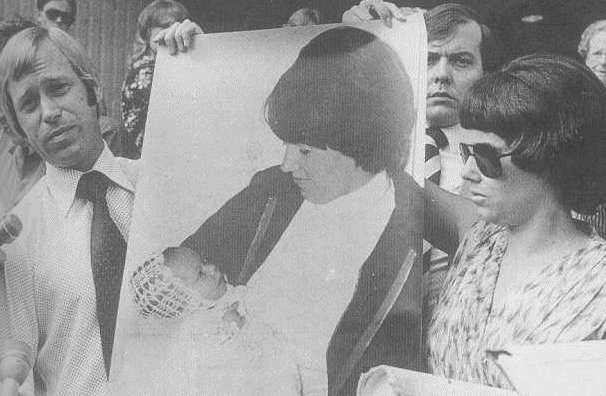
Michael and Lindy Chamberlain holding up photo of Azara after inquest
Despite the lack of a body, the lack of a motive, and the lack of any eye-witnesses, the Northern Territory opened its prosecution of (a now pregnant) Lindy and Michael Chamberlain in a modern two-story courthouse in Darwin on September 13, 1982. Justice James Muirhead, in crimson robes and a gray wig, sat on the bench in the crowded courtroom as attorneys for both sides worked to select twelve jurors from a panel of 123 all-white Territorians. When the selection process was completed, nine men and three women took their seats in the jury box. Defense attorney John Phillips was pleased with the group, telling his co-counsel Andrew Kirkham, "I think we've done well."
Ian Barker opened the case for the prosecution, telling jurors Azaria "died very quickly because somebody had cut her throat." Barker added, "The Crown does not venture to suggest any reason or motive for the killing. It is not part of our case that Mrs. Chamberlain had previously shown any ill will toward the child." Barker called Chamberlain's story about the dingo attack "a fanciful lie, calculated to conceal the truth."
The Crown's first witness, Ayers Rock tourist Sally Lowe, offered as much support for the defense as for the prosecution. Lowe described Lindy as being away from the barbecue only "six to ten minutes," a very short period in which to have committed the murder and temporarily disposed of the body, as the Crown claimed. Lowe also damaged the Crown's case by insisting, "I heard the baby cry--quite a serious cry," shortly before Lindy went to the tent and reportedly saw the dingo slinking off into the dark. On cross-examination, Lowe confirmed that she was "positive" she heard a baby cry--a cry that was suddenly cut off--and that the cry "definitely came from the tent." She also described Lindy before the incident having "a new-mum glow about her."
Testimony from others who were at the campground that August night generally presented a version of events that also seemed to aid the defense more than the prosecution, whose witnesses they were. Greg Lowe, Sally's husband, was asked on cross whether he saw any if the Chamberlains cleaning blood from their Torana at the time when, according to the prosecution timeline, they would have had to have done so. "No, I didn't," Lowe answered. "There were quite a lot of people around at that time at the tent-site, and I'm sure if anything like that happened it would have been noticed." Judy West reported she heard Lindy cry "The dingo's got my baby!" just "five to ten minutes" after she heard a dingo growl--"low" and "deep"--outside the tent. She also testified that earlier she had been forced to shoo off a dingo that had grabbed her twelve-year old daughter by the arm and pulled.
Witness Amy Whittaker, however, provided jurors with evidence of the seemingly odd behavior that had turned public opinion against the Chamberlains earlier in the investigation. Whittaker testified that minutes after the alleged dingo attack, Michael Chamberlain had appeared at the doorway of her camper and announced, "A dingo has taken our baby, and she is probably dead by now." Whittaker also reported Lindy saying, as she tried to comfort her, "Whatever happens, it is God's will." She also described Lindy and Michael walking alone together into the the bush for "fifteen to twenty minutes:--a time during which the prosecution later argued the Chamberlains might have buried their baby.
Because the prosecution case depended heavily on convincing jurors that the blood that turned up in the Chamberlain's car belonged to Azaria, the Crown called to the stand Keyth Lenehan, a bleeding hitchhiker picked up by the Chamberlains who the defense maintained might account for the presence of blood. Barker wanted to establish that Lenehan did not carry unusually high levels of fetal hemoglobin in his adult bloodstream. Still, the prosecution's calling of Lenehan prompted one journalist to tell an assistant prosecutor, "So far all you've done is convince everybody that Lindy is innocent."
Reporters saw the tide beginning to move a bit in the Crown's direction when a parade of forensic experts took the stand. Dr. Andrew Scott, a biologist from Adelaide, testified that his study suggested that the blood on Azaria's singlet flowed downward, from what appeared to be from the cutting by a sharp instrument, in the area of the neck. Barry Cocks testified that the jumpsuit seemed cut, not torn by a dingo. Professor Malcolm Chaikin, Australia's leading textile expert, demonstrated for the jury how cutting the jumpsuit produced small loops of toweling, much like those discovered by investigators in Michael Chamberlain's camera bag, where police suspected Lindy might have temporarily hid her dead baby. On cross, the defense got Chaikin to admit that the loops might also have come from a new, unwashed suit. (The Chamberlains said that they sometimes used the camera bag as a place to stuff Azaria's clothes.)
Biologist Joy Kuhl, the prosecution's thirty-fifth witness, presented what the Crown saw as some of its most damning evidence. Kuhl told jurors that her tests proved that the blood found on the dash support bracket in the Chamberlain's Torana belonged to an infant. On cross, Defense Counsel Phillips forced Kuhl to admit all the plates she used in her actual blood tests "have been destroyed"--a practice she called "standard procedure in our laboratory." Phillips also raised questions about the accuracy of her test results, suggesting that the blood--if that's what it was--might well have come from the bleeding hitchhiker picked up by the Chamberlains in 1979.
Crown witness Bernard Sims had investigated about two dozen attacks by dogs on humans in his job as a London ondontologist. Sims saw nothing consistent with a dingo attack in Azaria's clothing, claimed that a dingo attack would cause "copious" bleeding, and indicated that a baby's head could not fit into the jaws of a dingo. On cross, Sims reaffirmed that a the opening of a dingo's "mouth wouldn't allow it to get [over a baby's skull." Kirkham then surprised Sims with a photo of a dingo with the head of a baby-sized doll taken, crown first, with the canine teeth reaching to the doll's ears. Sims, staring at the photograph, could only concede that his earlier supposition might have been mistaken.
James Cameron was the final witness for the prosecution. Cameron, a professor of forensic medicine, testified that Azaria was killed by "a cutting instrument across the neck, or around the neck" held by a human. He exhibited to the jury slides of Azaria's clothing taken in his laboratory with ultra-violet light which he believed showed the pattern of bloodied fingers. Cross-examination focused attention on previous cases in which Cameron's pro-prosecution testimony had helped incriminate what turned out to be innocent suspects.
On October 13, the defense began its case. John Phillips ended his opening statement by pointing to the witness stand and saying, "I call Mrs. Chamberlain."
Tears slid down Lindy's face as she described the clothing her daughter was wearing the last night she laid her down: "She had a white knitted Marquis jacket, with a pale lemon edging." Phillips asked Lindy to place her index finger next to Cameron's exhibit which, the professor claimed, showed bloodied fingers. The point became obvious, when spectators realized that the print made by so-called bloodied fingers showed four phalanges, while Lindy Chamberlain, and virtually every other human on the planet, have only three.
Much of Ian Barker's cross-examination of Lindy was devoted to poking holes in her story about seeing a dingo in the vicinity of the family tent. He asked her to explain how a dingo, shaking a bleeding baby, would not have left large quantities of blood in and around the tent. He also challenged the defendant to account for the fetal blood which his experts claimed to have found in the family car. Lindy resisted saying, "I'm not going to speculate how it got there." Near the end of his long cross-examination Barker began asking "questions" that were really just statements for the jury. "Mrs. Chamberlain," the Queen's Counsel said at one point, "may I respectfully suggest to you that the whole [dingo] story is mere fantasy?"
More than two dozen defense witnesses followed Lindy to the stand. Several testified as to the Chamberlain's fine character and their grief over the loss of their daughter. Other witnesses told either of their own frightening encounters with Ayer's Rock dingoes, or testified in general about the aggressiveness of the region's wild dogs. In addition, eight defense forensic experts would attack the dubious tests or conclusions of the prosecution's experts, on subjects ranging from fiber to blood evidence.
The defense saw Professor Barry Boettcher as one of its most important forensic experts. Boettcher attacked Joy Kuhl's conclusions that the Chamberlain car contained significant quantities of fetal blood. In complicated testimony that might have flown right over the heads of the jurors, Boettcher tried to explain why Kuhl's testing method might have produced false positives for fetal blood. Later, another expert, Richard Nairn would also pile on Kuhl's results, arguing that the sheer number of Kuhl's tests was irrelevant: "Two hundred bad tests are poorer than one good test."
Some of the most riveting defense testimony came from defense dingo expert Les Harris contended that a dingo after prey the size of Azaria would "make seizure, which would be of the entire head, and it would close its jaws sufficiently to render the mammal immobile." It would be most unlikely to "hang around" with its prey, Harris contended. Harris said dingo kills in the field produce "very little" blood and that they characteristically shake their heads after taking prey "to break the neck."
Except for one recalled expert, the last defense witness was Michael Chamberlain. Ian Barker, in his cross-examination of Michael, focused heavily on the his actions in the first hours after Azaria's disappearance. Barker suggested that Michael's failure to ask Lindy certain questions, or to go running off into the brush in search of his daughter, was because he already knew Lindy had killed his daughter: "Could it be because you knew that the dingo did not take her, and that she was dead at the hands of your wife?" Michael answered, in a low voice, "No." Barker pushed hard: "The whole story is nonsense, and you know it." "No, Mr. Barker," Michael insisted again. Courtroom observers concluded that Chamberlain's testimony lacked spirit; it seemed both weary and inappropriately nonchalant. When his long hours on the stand finally ended, he took a seat in the courtroom next to his wife, and held her hands.
Phillips, in his summation, stressed that the prosecution failed to provide even a remotely plausible explanation as to why Lindy Chamberlain would want to kill her own child. "The prosecution has had two years and three months to think of a reason," he said, and "they can't."
Barker, summing for the Crown, admitted that no motive had been proved, but insisted that was neither the prosecution's intent or its job. "All the Crown says is that you should find the murder happened," Barker told the jury. He turned the tables by asking the jury to consider the lack of evidence that might suggest the dingo was guilty. "How could you possibly convict [the dingo] on this evidence?" he asked, noting the lack of dingo hairs or drag marks by the tent, the fact that no one saw it carrying a baby, and the relatively undamaged condition of Azaria's jumpsuit. "The case against the dingo would be laughed out of court," Barker concluded.
On October 28, 1982, Justice Muirhead instructed the jury--in a manner that generally pleased the defense. He reminded them that Sally Lowe distinctly remembered hearing a baby's cry coming from the Chamberlain's tent, and that if she was correct about that, then the prosecution's assertion that Azaria was at the time lying dead in the Chamberlain's car with her throat cut could not be true. Most journalists left the Darwin courtroom expecting an acquittal.
On October 29, at 8:37 pm, the foreman of the Chamberlain jury announced its verdict. The jury found Lindy guilty of murder, and Michael guilty of being an accessory after the fact. Across Australia, the jury's verdict was greeted mostly with approval and, in places ranging from a speedway in Perth to a bar in Darwin to a convention of dentists in Newcastle, with sustained applause. Reports later indicated that the jury was initially considerably more divided that its verdict indicated, having first split four for conviction, four for acquittal, and four undecided. (One juror later told the press, "It came down to whether you believed it was a dingo or not.")
Justice Muirhead sentenced Lindy to life in prison, but suspended Michael's sentence. "I consider it not only appropriate, but in the interests of justice to do so," he explained.
The Trial Aftermath
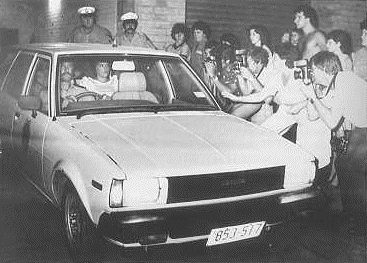
Chamberlains leaving courthouse on their way to prison
One month after beginning her sentence at Berrimah prison outside of Darwin, Lindy Chamberlain gave birth to a second daughter, which she Kahlia. "Let them try to make something out of that," she said.
Lindy regained some freedom, temporarily, when she was released on bail pending her appeal. Her appeal to the Federal Court was rejected, 3 to 0, in April of 1983. Ten months later, Australia's High Court also refused to set aside her conviction, on a 3 to 2 vote, and Lindy found herself back on Block J of Berrimah Prison.
As Lindy passed her days in a fortress on a ridge near Darwin, new reports casting doubt on the prosecution's scientific evidence helped spur a growing Free Lindy movement. Most damning of all the new reports was one showing that what the prosecution had claimed was the blood of a murdered child in the Chamberlain vehicle was in fact not even blood at all--it was paint emulsion. Well over 100,000 Australia's signed petitions calling for her release. The country remained, however, deeply divided on the issue, with one poll showing 52% of the nation's residents believed her guilty of murder.
An English hiker named David Brett would, quite unintentionally, succeed in gaining Lindy's release after so many before him had failed. He did so in January 1986 by falling off Ayer's Rock during an evening climb and killing himself. Eight days after his accident, Brett's body was discovered below the bluff where he had lost his footing, in an area full of dingo lairs. As police scoured the area, looking for missing bones that might have been carried off by dingoes, they discovered a once white jacket of a baby: Azaria's missing matinee jacket.
Given the skepticism prosecutors had expressed for Lindy's story about the missing matinee jacket, there seemed little choice now. The Chief Minister ordered Lindy's release from prison. Wearing a pink frock and sunglasses, Lindy climbed into a limousine at the gates of Berrimah prison on February 7, 1986 and tried to begin a second life.
A judicial inquest followed Lindy's release from prison, and in this one former prosecution witnesses had a lot of explaining to do. In May 1987, Justice Trevor Morling issued a 379-page report critical of the investigatory techniques of Joy Kuhl, James Cameron, and other key prosecution witnesses in the trial. He put great weight on the credible accounts offered by the Chamberlain's fellow campers, noting: "It is extraordinary that the persons at the barbecue area at the time of and immediately after Azaria's disappearance accepted Mrs. Chamberlain's story and noted nothing about her appearance and conduct suggesting that she had suddenly killed her daughter." Morling concluded, "I am far from being persuaded that Mrs. Chamberlain's account of having seen a dingo near the tent was false" and that "if the evidence before the Commission had been given at the trial, the trial judge would have been obliged to direct the jury to acquit the Chamberlains."
On September 15, 1988, the Northern Territory Court of Criminal Appeals unanimously quashed all convictions against Lindy and Michael Chamberlain. A month later, the Chamberlains held a victory feast for invited guests at the Avondale College cafeteria. Among those invited by the Chamberlains were defense witnesses and lawyers, a couple whose daughter was taken from their car by a dingo, and journalists and politicians who had supported them during their long ordeal. Lawyer Ken Crispin, in a speech, praised the Chamberlains for being remarkably free of bitterness or self-pity.
The Chamberlains traveled to Sydney to see a preview of the movie based on their experience, "A Cry in the Dark." Lindy, in her book "Through My Eyes," called the movie, based on John Bryson's fine account of the case, 95% accurate and said that "no other actress would have been able" to play her better than Meryl Streep.
Lindy Chamberlain wrote in the last pages of her 1990 book, "And now we wait, we wait for the Northern Territory to pay us what they owe." That day finally came two years later when she received $1.3 million in compensation from the Northern Territory government for wrongful imprisonment.
The Final Chapter?
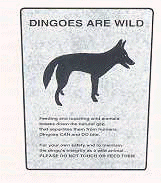
In February 2012, a fourth coroner's inquest into the death of Azaria Chamberlain was opened by Territory Coroner Elizabeth Morris. Morris considered new evidence concerning dingo attacks on humans, including three fatal attacks on children since the third inquest, before concluding in an opinion announced on June 12, 2012, that a dingo did indeed kill Azaria. Morris wrote, "The evidence is sufficiently adequate, clear, cogent, and exact" to "exclude all other reasonable probabilities" than that a dingo entered the tent where Lindy and Michael Chamberlain's young child lay resting on that August night thirty-two years earlier. Lindy Chamberlain-Creighton stated the obvious when she said, "This battle to get the legal truth about what caused Azaria's death has taken too long." Still, however, she took consolation in knowing "you can get justice when you think all that is lost." Lindy hoped that her baby's death helped convince Australians that dingoes are dangerous animals. "We live in a beautiful country," she said, "but it is dangerous and we would ask all Australians to take proper precautions." Even with the cause of death on Azaria's death certificate changed from "unknown" to "dingo attack," the Chamberlain's attorney, Stuart Tipple, wondered whether any amount of evidence would satisfy some Australians who still blame Lindy: "I could show them a video of the dingo taking the baby and it wouldn't convince them."
